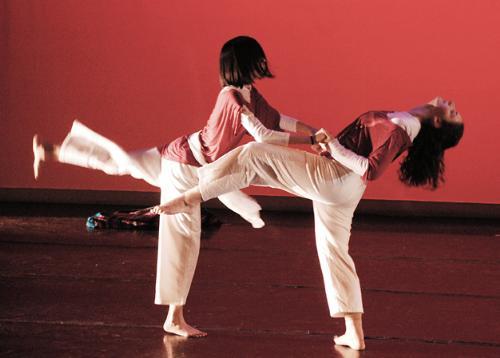
Left to right, Gabriela Pena ’08 and Anna C. Walters ’06 perform in the dance “Renacer,” part of Harvard Radcliffe Dance Company’s Me in a Box.
A red scarf envelopes a struggling dancer in one sequence. In another, a girl in oversized sunglasses carefully and thoroughly peels an orange. Brightly dressed dancers swoop and swirl through the versatile space of the Rieman Center for Performing Arts. Me in a Box, the Harvard Radcliffe Dance Company’s (HRDC) Winter Concert, is hardly as constraining as its title implies.
The HRDC is like a conversation between friends: irreverent and exuberant, but running into surprising moments of depth. Most of all, the fluid choreography and minimal use of props makes each of the 10 sequences seem natural and fun.
The first set of pieces focus solely on physical aspects. “Burning Desire” starts the show slowly and shallowly; the languid motions of the dancers aren’t meant to mirror the emotion of the title, but only to spark it. The shimmery gowns make the dancers seem ephemeral and almost fairy-like, contributing to the emphasis on the fleeting and the physical.
The second piece, “Interlude,” elaborates on mere movement by focusing on the contact between dancers. Three actresses in primary colors stride purposefully across the stage; when they collide, their reactions become exaggerated and often change the trajectory of each across the stage.
The effect is akin to watching the rattling and zigzagging of a pinball machine set to Moby’s “Sync.” The collisions of the dancers emphasize the wide-reaching effects of human interaction. The active, focused choreography and its fit to the equally vigorous music make this one of the most enjoyable pieces of the show, despite its brevity.
“Renacer” continues the theme of expressing emotions in physical movement. The sporadic, almost stuttering motions of its performers seems to catch motion in midair. The piece’s South American wind-flute tones emphasize the exotic and magical feel of “Renacer” (“rebirth” in Spanish).
As its title suggests, “A Deeply Political Work” shifts the focus of Me in a Box from motion to meaning. Two performers (Neil G. Ellingson ’05 and Alex L. Pasternack ’05, who is also a Crimson editor) who epitomize the artistic stereotype of male dancers—complete with gauzy scarves and embarassingly tight tights—embark on a confusingly symbolic routine replete in artistic pretension.
A heckler’s comments inspire the duo to challenge the audience to do better. Some members descend to the dance floor and breakdance against the feeble attempts of the dancers, in a revolution against traditional “high art” definitions of dance: in this show, breakdancing can be art, too, and the audience can participate in the show alongside the actors.
The next piece, “Boundaries,” uses a single prop to skillfully illustrate its title subject in a superb mesh of graceful choreography and music (“Silence” by Delerium). The choreography is perhaps the best of the show, technically speaking; it retains the characteristic fluidity of Me in a Box despite its complexity. The dancers’ motions revolve around a gauzy red cloth that serves as a tangible boundary between the figures. Its presence sometimes separates one from the rest, but then brings the group together, stretching the “boundary” in physical reality and meaning.
“Chattanooga Springs” is one of the most reflective and haunting pieces in the show. Set to the Decemberists’ “Here I Dreamt I Was an Architect,” it uses the setting of classic small-town America to comment on the corruption of modernity. Through the loss of its characters’ innocence—a boy takes a swig of alcohol for the first time, another takes the orange that a blind girl is carefully peeling and bites into it almost maliciously—the piece becomes a bittersweet expression of regret for days gone by and the desire to protect one from the outside world. When the characters come together at each chorus, their slow and dreamy twirling feels like a country dance that suits the setting well.
Jetta G. Martin ’05 follows “Springs” with a solo performance in “Emergence,” demonstrating an astounding ability for intricate footwork. Her complex choreography brings order to a cacophonous blend of Bjork and Kelis, “Oceania,” with increasingly dramatic spirals around the stage that mirror the growth implied in the title.
“Oh, Come On...” and “Breaking the Last Thread” both follow “Emergence” with messages about making the most of life. “Oh, Come On...” stresses the importance of group unity with a six-person cast, a strong disco beat, and innovative choreography. “Breaking the Last Thread,” a solo performance by Marin J.D. Orlosky ’07, tells the story of a woman struggling to survive despite great odds. Her graceful movements reflect the passion of the heroine of Tori Amos’ “Me and a Gun.”
The show’s closer is appropriately titled “Out of Time.” Its upbeat rock tunes and bright costumes emphasize the message that dance should be fun, not formal. As crowds of dancers walk confidently across the stage, the sense of urgency in their headbanging and dancing—“Unrest” is printed on one dancer’s shirt—mimics the hurriedness of everyday life. It suggests that dance has a place in the ordinary.
“Out of Time” ends with the casual words “see you later.” This serves as a summary for the whole show: it need not be confined to theatres and the stiffness of stage. Me in a Box demonstrates that dance has a place in the everyday, one that is both vital and natural.
Read more in News
Quincy Considers Restrictions












